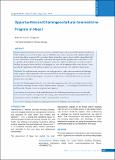Please use this identifier to cite or link to this item:
https://hdl.handle.net/20.500.14356/1752Full metadata record
| DC Field | Value | Language |
|---|---|---|
| dc.contributor.author | Bhatta, R | - |
| dc.contributor.author | Aryal, K | - |
| dc.contributor.author | Ellingsen, G | - |
| dc.date.accessioned | 2023-05-21T07:29:56Z | - |
| dc.date.available | 2023-05-21T07:29:56Z | - |
| dc.date.issued | 2015 | - |
| dc.identifier.citation | BhattaR., AryalK., & EllingsenG. (2015). Opportunities and Challenges of a Rural-telemedicine Program in Nepal. Journal of Nepal Health Research Council. https://doi.org/10.33314/jnhrc.v0i0.640 | en_US |
| dc.identifier.issn | Print ISSN: 1727-5482; Online ISSN: 1999-6217 | - |
| dc.identifier.uri | http://103.69.126.140:8080/handle/20.500.14356/1752 | - |
| dc.description | Original Article | en_US |
| dc.description.abstract | Abstract Background: Telemedicine services are considered essential for improving the accessibility, quality and efficiency of the healthcare services in developing countries. With these expectations, government of Nepal has implemented a rural-telemedicine program in thirty peripheral district hospitals to improve the accessibility of specialist health services. Telemedicine can be appropriate to the nation like Nepal with low physician/patient ratio. However the acceptability of telemedicine can be a delayed process, where the healthcare modalities are not well internalized. Similarly, the peoples who are involved in the program play a key role for making it efficient and effective. Hence, assessing the opportunities and challenges is important to address needs and better implement the program. Methods: This study has used an interpretive case study approach to explore the opportunities and challenges of the program. Fifteen stakeholders were interviewed from central level and program sites namely Darchula, Sindhupalchowk and from Patan hospital. Discussions at peripheral sites with stakeholders were recorded and intensive notes were taken. Results: The findings suggested that the rural-telemedicine programme does offer some benefits, however there are still many challenges associated with the implementation of program. These challenges include infrastructure problems, lack of human resources, competence and financing. Conclusions: Overall attitude of the stakeholders involved in delivering telemedicine services was favorable however several loopholes were reported in the existing system. Hence it shows sufficient potentialities of rural- telemedicine to improve the health care delivery in rural and inaccessible areas. Keywords: Challenges; local practice; nepal; opportunities and limitation; rural-telemedicine. | en_US |
| dc.language.iso | en | en_US |
| dc.publisher | Nepal Health Research Council | en_US |
| dc.relation.ispartofseries | May-Aug, 2015;640 | - |
| dc.subject | Challenges | en_US |
| dc.subject | Local practice | en_US |
| dc.subject | Nepal | en_US |
| dc.subject | Opportunities and limitation | en_US |
| dc.subject | Rural-telemedicine | en_US |
| dc.title | Opportunities and Challenges of a Rural-telemedicine Program in Nepal | en_US |
| dc.type | Journal Article | en_US |
| local.journal.category | Original Article | - |
| Appears in Collections: | Vol. 13 No. 2 Issue 30 May - August 2015 | |
Files in This Item:
| File | Description | Size | Format | |
|---|---|---|---|---|
| 640-Article Text-1176-2-10-20160103.pdf | Fulltext Download | 186.37 kB | Adobe PDF |  View/Open |
Items in DSpace are protected by copyright, with all rights reserved, unless otherwise indicated.
